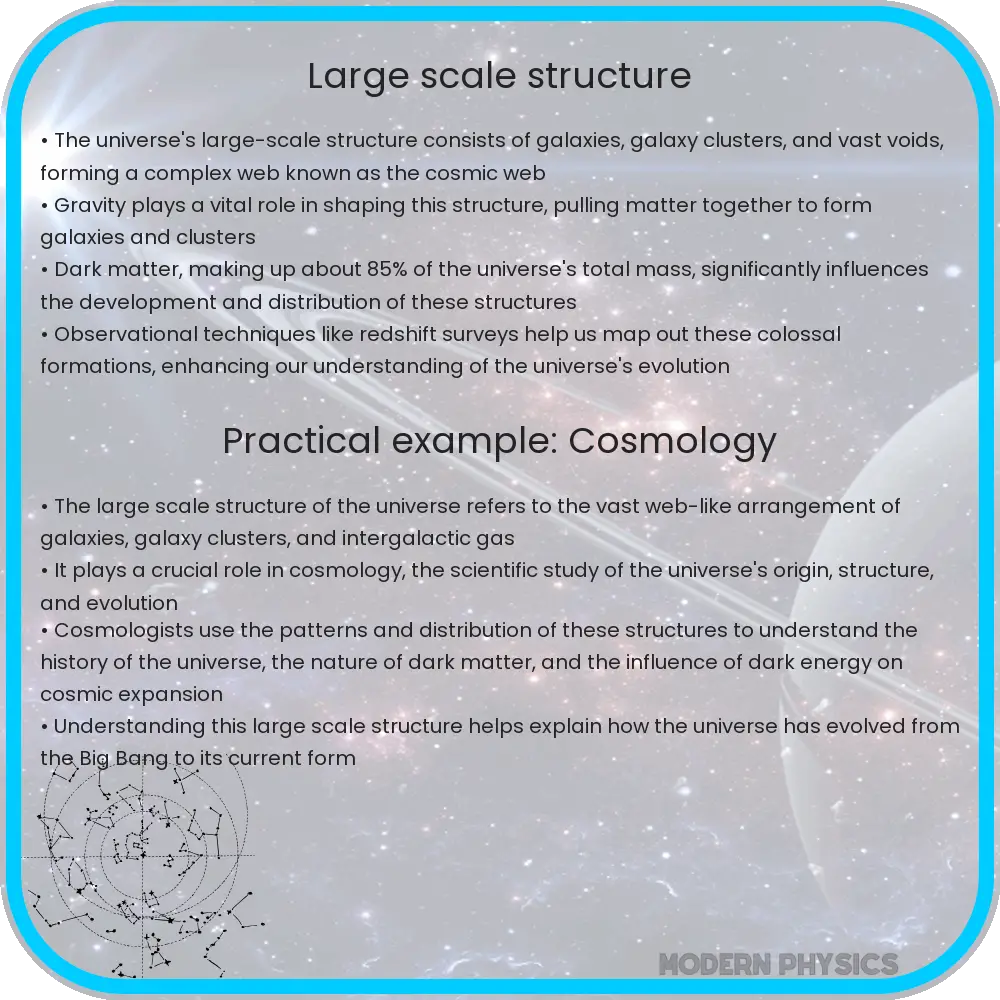Explore the large-scale structure of the universe, dark matter, cosmic maps, and the forces shaping cosmic evolution in this insightful article.

Exploring the Large Scale Structure of the Universe
The cosmos, a vast expanse of intergalactic space, stars, and celestial bodies, holds mysteries that scientists and astronomers have endeavored to understand for centuries. Among the most fascinating aspects of astronomical research is the study of the Large Scale Structure (LSS) of the universe. This structure represents the distribution of matter, primarily galaxies and galaxy clusters, across the cosmos, revealing a web-like pattern often referred to as the “cosmic web.
At the heart of understanding this immense structure lies the role of dark matter, an invisible component that comprises approximately 85% of the total matter in the universe. Despite being undetectable through direct observation, dark matter’s gravitational effects are observable on the motion of galaxies and cosmic microwave background radiation. The distribution of dark matter in the universe helps form the cosmic web, with dense regions attracting more matter and thus forming galaxies and clusters.
Mapping the Cosmic Web
Scientists map the LSS through extensive surveys and observations, employing techniques such as redshift measurements to determine the distance of galaxies. By analyzing the light from distant galaxies, astronomers can infer their velocities and thus their relative positions in space. This information helps create three-dimensional maps of the universe, illustrating the distribution of galaxies and voids. These maps are crucial for understanding the evolution of the cosmos and the underlying physics governing it.
The Role of Dark Matter in Cosmic Evolution
The concept of dark matter is integral to the formation and evolution of the Large Scale Structure. Theories such as the Cold Dark Matter (CDM) model postulate that dark matter particles moved slowly compared to the speed of light, leading to the gradual accumulation of matter in certain regions and the formation of the cosmic web. This process, known as hierarchical clustering, suggests that small structures like dwarf galaxies formed first, eventually merging to create larger galaxies and galaxy clusters observed today.
Understanding the LSS and the role of dark matter not only sheds light on the composition of the universe but also on its history and its continuous evolution. The study of cosmic maps and the distribution of galaxies helps astronomers and physicists piece together the complex puzzle of the cosmos, offering insights into the fundamental laws that govern the universe.
Understanding the Cosmic Tapestry
The cosmos is a vast, intricate tapestry woven with galaxies, stars, and the mysterious substance known as dark matter. The study of the large-scale structure of the universe reveals how matter is distributed across the cosmos, providing insights into the fundamental forces that have shaped the universe from the Big Bang to the present day.
Mapping the Universe
Astronomers and cosmologists use a variety of techniques to map the large-scale structure of the universe. These cosmic maps reveal the filamentary structure of galaxies, known as the “cosmic web,” where galaxies are strung like pearls along immense threads of dark matter. These structures are not random; they are the result of fluctuations in the density of matter in the early universe, magnified over billions of years by the force of gravity.
Dark Matter: The Cosmic Scaffold
One of the most significant discoveries in astrophysics is the existence of dark matter. Although it does not emit, absorb, or reflect light, dark matter comprises approximately 85% of the universe’s total mass. Its presence is inferred from its gravitational effects on visible matter, radiation, and the large-scale structure of the universe. Dark matter acts as a cosmic scaffold around which visible matter clusters, forming galaxies and galaxy clusters.
The Evolution of the Universe
The large-scale structure of the universe has evolved over billions of years, from the uniformity of the cosmic microwave background radiation to the complex structures observed today. This evolution is governed by the interplay between dark matter, dark energy, and visible matter. Dark energy, a mysterious force that is driving the accelerated expansion of the universe, plays a crucial role in shaping the large-scale structure.
Conclusion
The study of the universe’s large-scale structure offers profound insights into the nature of the cosmos. Cosmic maps not only reveal the distribution of galaxies and dark matter but also serve as time capsules that allow us to peer back into the early history of the universe. By understanding the large-scale structure, scientists can unravel the mysteries of dark matter, dark energy, and the fundamental forces that govern the evolution of the cosmos. As technology and methodologies improve, our cosmic maps will become even more detailed, bringing us closer to understanding the ultimate fate of the universe.
